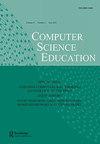学生对动态编程的误解:一项复制研究
IF 2.2
Q1 EDUCATION & EDUCATIONAL RESEARCH
引用次数: 3
摘要
摘要背景和上下文我们复制并扩展了以前关于学生如何学习动态编程的工作,这是算法课上学生的一个难题。他们的研究在一个学期内采访了一所大学的一些学生。我们在大型公立和私立大学以及文科学院招募了更大样本量的学生,为期数个学期。目的我们的目的是调查先前工作的结果是否适用于其他大学以及更大的学生群体。方法我们采访了完成算法课相关部分的学生,要求他们解决问题。我们观察了学生解决问题的过程,以了解学生如何解决这些问题。研究结果我们发现,学生通常在三个方面挣扎,“技术选择”、“重复构建”和“低效实施”。然后,我们定性地探讨了这些主题和具体的误解。我们观察到,先前工作中发现的误解普遍存在于更大的学生样本中。启示我们的研究结果展示了学生们在哪些领域苦苦挣扎,通过识别共同弱点的领域来吸引导师的注意力,为更好的算法教育铺平了道路。本文章由计算机程序翻译,如有差异,请以英文原文为准。
Student misconceptions of dynamic programming: a replication study
ABSTRACT Background and Context We replicated and expanded on previous work about how well students learn dynamic programming, a difficult topic for students in algorithms class. Their study interviewed a number of students at one university in a single term. We recruited a larger sample size of students, over several terms, in both large public and private universities as well as liberal arts colleges. Objective Our aim was to investigate whether the results of the previous work generalized to other universities and also to larger groups of students. Method We interviewed students who completed the relevant portions of their algorithms class, asking them to solve problems. We observed the students' problem solving process to glean insight into how students tackle these problems. Findings We found that students generally struggle in three ways, “technique selection,” ”recurrence building,” and “inefficient implementations.” We then explored these themes and specific misconceptions qualitatively. We observed that the misconceptions found by the previous work generalized to the larger sample of students. Implications Our findings demonstrate areas in which students struggle, paving way for better algorithms education by means of identifying areas of common weakness to draw the focus of instructors.
求助全文
通过发布文献求助,成功后即可免费获取论文全文。
去求助
来源期刊

Computer Science Education
EDUCATION & EDUCATIONAL RESEARCH-
CiteScore
6.90
自引率
3.70%
发文量
23
期刊介绍:
Computer Science Education publishes high-quality papers with a specific focus on teaching and learning within the computing discipline. The journal seeks novel contributions that are accessible and of interest to researchers and practitioners alike. We invite work with learners of all ages and across both classroom and out-of-classroom learning contexts.
 求助内容:
求助内容: 应助结果提醒方式:
应助结果提醒方式:


